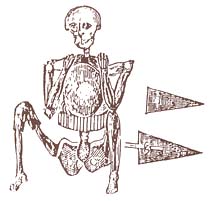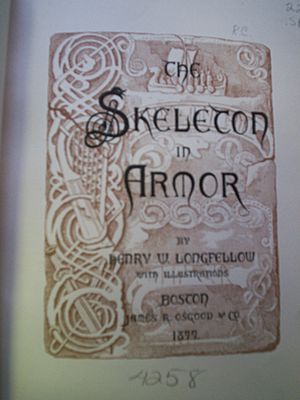The Skeleton in Armor facts for kids
The Skeleton in Armor is the name given to a skeleton found with old metal, bark, and cloth items. It was discovered in Fall River, Massachusetts in 1832. Sadly, the skeleton was later destroyed in a fire in 1843. This name is also used for a famous poem by Henry Wadsworth Longfellow.
Contents
Discovery of the Skeleton
In 1832, some people were digging in a sandbank in Fall River. They found a human skeleton buried in a sitting position. The skeleton was found near the surface of the ground.
When it was found, the skeleton had some interesting items with it. There was a triangular brass plate covering its chest. Around its body was a wide belt made of many small brass tubes. People also found arrowheads made of copper or brass in the same grave.
One person who described the skeleton was Dr. Phineas W. Leland in 1843. He said the skeleton was "quite perfect." He also mentioned that many people thought it was the remains of a Native American person. This was because of the shape of the skull and how the body was found. Other skeletons were also found nearby.
Another description came from John Stark, a lawyer, in 1837. He noted that the body was wrapped in a covering of coarse bark. Inside that, there was another layer of coarse cloth. The brass plate on the chest was about 13 inches long. The belt was made of brass tubes, each about four and a half inches long. Stark also described the brass arrows. He noted that the way the arrows were made was different from how Native Americans usually made them.
Some parts of the body, like the skin on the right knee, hands, and arms, were surprisingly well-preserved. This might have happened because of a special embalming process. Or it could have been due to chemicals from the brass items.
How the Skeleton Was Lost
After it was found, the skeleton was moved to the Fall River Athenaeum. This was a library where it was put on display in a glass case. The arrow tips were also shown with it.
However, a terrible event happened on July 2, 1843. A huge fire, known as the "Great Fire", swept through Fall River. The Athenaeum and much of the town were destroyed. Sadly, the Skeleton in Armor was lost in this fire.
Who Was the Skeleton?
Since the skeleton was destroyed, scientists cannot study it today. But at the time, people had many ideas about who it might have been.
Native American Chief
Many people believed the skeleton belonged to a Native American chief. Fall River is in an area where the Narragansett and Wampanoag tribes lived. Brass items were traded with Native Americans. For example, traders sold brass kettles, and Native Americans would use the metal to make arrowheads. Some arrowheads found with the skeleton were similar to those used by the Iroquois in the 1600s.
Ancient Sailors or Explorers
Some people had a very different idea. They thought the skeleton might have been from ancient sailors, like the Phoenicians, Carthaginians, or Egyptians. These groups were known for their sailing skills long ago. The idea was that their ships might have been blown off course and reached North America.
This theory was popular at the time. People used it to explain ancient structures in the Americas, like Chichen Itza. They sometimes found it hard to believe that local civilizations built such amazing things. Today, most historians do not believe these ancient groups regularly traveled to North America before Columbus. However, the idea of an accidental, one-time visit was considered.
One problem with this theory is how well the body was preserved. If it was buried in moist soil, it would usually decompose quickly. It would be very unusual for a body to last for thousands of years in those conditions.
Early European Settler
Another idea was that the skeleton belonged to an early European colonist or explorer. The armor described with the skeleton does not sound like what early European settlers in the area usually wore. But since the skeleton is gone, it is hard to completely rule out this idea.
A Hoax
Finally, some people wondered if the whole discovery was a trick or a joke. However, there was no clear reason why someone would create such a fake at that time.
Longfellow's Famous Poem
The discovery of the Skeleton in Armor inspired the famous American poet Henry Wadsworth Longfellow. He wrote a poem called "The Skeleton in Armor." Longfellow seemed to think the skeleton might have been from a Norse (Viking) explorer. He knew about writings that suggested the Norse had explored North America long ago.
Longfellow's poem was first published in 1841. In the poem, he also mentions the Newport Tower in Newport, Rhode Island. Some people thought this stone tower might have been built by Vikings. However, it is more likely it was built in the 1600s by early European settlers.
Remembering the Skeleton
In 1903, the city of Fall River placed a bronze tablet on a building. This tablet was put up to remember where the Skeleton in Armor was found. The tablet was 24 by 20 inches. It said: "A Skeleton In Armor was found near this spot by Hannah Borden Cook In the month of May A D 1831 This Tablet was placed here by the Women's Educational and Industrial Society of Fall River Mass May 27th A D 1903".
In 2018, the tablet was stolen by metal thieves. But it was found and put back in a safer place.



